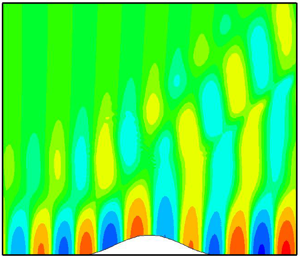Article contents
An asymptotic theory of the roughness impact on inviscid Mack modes in supersonic/hypersonic boundary layers
Published online by Cambridge University Press: 26 February 2021
Abstract

In this paper, we develop a large-Reynolds-number asymptotic theory to describe the impact of a localised roughness element on oncoming inviscid first and second Mack modes in supersonic or hypersonic boundary layers. The height and width of the roughness are assumed to be of  $O(R^{-1/4}\delta ^{*})$ and
$O(R^{-1/4}\delta ^{*})$ and  $O(R^{1/4}\delta ^{*})$, respectively, such that the induced mean-flow distortion is described by the triple-deck formalism, where
$O(R^{1/4}\delta ^{*})$, respectively, such that the induced mean-flow distortion is described by the triple-deck formalism, where  $R$ is the Reynolds number based on the local boundary-layer displacement thickness
$R$ is the Reynolds number based on the local boundary-layer displacement thickness  $\delta ^{*}$. As the wavelength of the inviscid Mack mode is comparable with
$\delta ^{*}$. As the wavelength of the inviscid Mack mode is comparable with  $\delta ^{*}$, its interaction with the roughness forms a multi-scale problem. The Mack mode in the bulk of the boundary layer is described by the inviscid Rayleigh equation, whose evolution near the roughness is formulated by use of the solvability condition. It is found that the dominant roughness effect is attributed to both the interaction of the oncoming perturbation with the mean-flow distortion in the main layer and the inhomogeneous forcing from the curved wall (Stokes layer). This theory enables us to probe the scattering process when the frequency approaches the synchronisation frequency, which is recognised as the critical site distinguishing the destabilising and stabilising roles of the roughness. An improved asymptotic theory is also developed, which increases the accuracy of the asymptotic prediction, especially at the intersection frequency of the first and second modes. We also carry out harmonic linearised Navier–Stokes calculations and direct numerical simulations to confirm the accuracy of the asymptotic predictions, and favourable agreements are obtained even when the roughness height is a quarter of the nominal boundary-layer thickness.
$\delta ^{*}$, its interaction with the roughness forms a multi-scale problem. The Mack mode in the bulk of the boundary layer is described by the inviscid Rayleigh equation, whose evolution near the roughness is formulated by use of the solvability condition. It is found that the dominant roughness effect is attributed to both the interaction of the oncoming perturbation with the mean-flow distortion in the main layer and the inhomogeneous forcing from the curved wall (Stokes layer). This theory enables us to probe the scattering process when the frequency approaches the synchronisation frequency, which is recognised as the critical site distinguishing the destabilising and stabilising roles of the roughness. An improved asymptotic theory is also developed, which increases the accuracy of the asymptotic prediction, especially at the intersection frequency of the first and second modes. We also carry out harmonic linearised Navier–Stokes calculations and direct numerical simulations to confirm the accuracy of the asymptotic predictions, and favourable agreements are obtained even when the roughness height is a quarter of the nominal boundary-layer thickness.
JFM classification
- Type
- JFM Papers
- Information
- Copyright
- © The Author(s), 2021. Published by Cambridge University Press
References
REFERENCES
- 22
- Cited by





